Table of Contents+
If you’re heavily invested in the powerlifting and bodybuilding worlds or know someone who trains in these manners, then I’m sure you’ve seen someone lifting in Converse or heard at some point that Converse shoes are a good shoe for lifting.
Does this sentiment still stand true today? As the shoe industry and strength sports have grown, there are now more options than ever for lifting. So sure — Converse can work for lifting — but I’ll unpack why they’re kind of “meh” below.
For context, the reality is that there are a ton of great shoes for squatting, deadlifting, and cross-training. Plus, we could also consider the fact that we know a lot more about lifting mechanics now and how shoes can specifically influence our lifts.
They don’t build them like they used to. I sound like my dad saying that, but it’s somewhat true for Converse in the gym compared to the old school models (pre Nike buy out). For lifting specifically, here are my quick takes if you don’t feel like reading this full article.
- For general strength and hypertrophy workouts, Converse can work great. They’re stable enough for most lifters. I’ve deadlifted 555 lb and squatted 440 lbs in Converse with no issues.
- Their “newer” insoles give them a 7-8mm heel-to-toe drop, so they’re not longer a “zero drop” shoe unless you take out the insole to train and replace it with a flatter insole.
- If you take out the insole, then you bring down this shoe’s stack height considerably (Stack Height = the amount of material between your feet and the floor.). This can be a sneaky tactic for using your Converse for deadlifts and making them much more minimalist.
- The outsole tread still start to fade and get fuzzy around 7-8 months of gym and every day wear, which is why I don’t love the newer Converse for lifting. They can get slippery over time and I think the older models had better rubber coverage.
- All-in-all, they can work fine for lifting, but keep in mind they’re not a zero-drop shoe unless you take their insole out, the outsole can fade if you’re wearing them all of the time outside of the gym, and they don’t have the best versatility.
Are Converse Good for Lifting?
If you want to use Converse for lifting, you most certainly can and this article is not intended to totally bash them or scare you away from using Converse.
In fact, Converse was the first shoe I used for powerlifting and the first shoe I deadlifted 500 lbs in, so they have a special place in my heart.
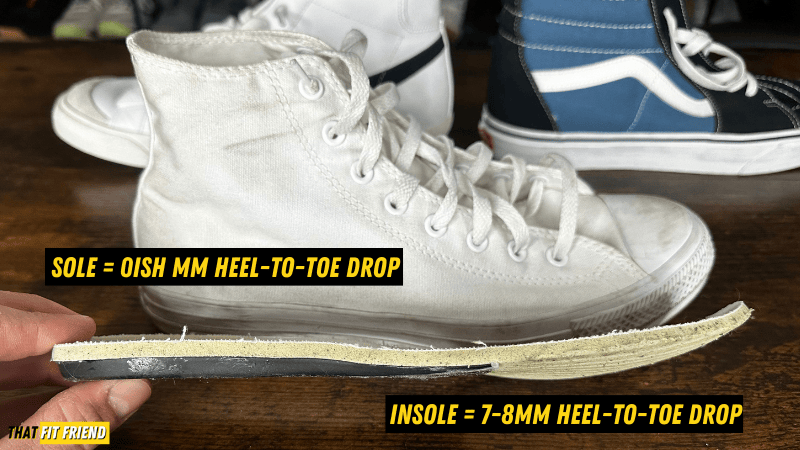
My issue with Converse, though, is that there are far better options on the market in 2023 that will deliver constructions that are more specific to weight training. I think if you’re not married to Converse, then you can find better shoes to support your gym performance and I’ll cover a few options below.
Why Are Converse Popular Gym Shoes?
While there’s no concrete origin story behind Converse and their rise to popularity in the gym, there’s a strong case to be made that their popularization came with the growth of strength sports.
More specifically, Converse shoes have been used in powerlifting for years, and for a while, they were the go-to shoe for a wide range of elite powerlifters.
With both the growth of strength sports and powerlifting concepts being used in traditional strength training, I think a lot of lifters looked at these athletes and started to wear the gear they were using. Before Nike bought Converse and changed their insole construction, Converse had been relatively unchanged for years.

This unchanged tried and true classic Converse delivered a stable rubber outsole and a relatively minimalist insole with a 7-8mm heel-to-toe drop and 0mm with insole removal. Thus making them a powerlifting-friendly shoe because, at the time of their initial popularization, there were not nearly as many footwear options as we have today.
For example, deadlift shoes and deadlift slippers were not really well-known things at the time. Lifters would reach for Converse for their heaviest sets of squats and deadlifts because they were stable and offered a flat construction. This flat heel-to-toe drop is desired by a variety of lifters who adopt a low-bar squat position and want to maximize their deadlift potential.

In the present day, Converse shoes have changed to be a bit more comfortable due to the reworked insole construction Nike gave them. Additionally, Converse shoes have become a streetwear staple with so many different colorways and limited edition collaboration projects.
Their ability to be fairly good shoes for the gym and their style for daily wear help to keep them popular today. Plus, I do think there’s a subtle undertone for some lifters who wear Converse of not wanting to give up a tried and true lifting classic for newer models that may be slightly better.
Why Do People Wear Converse to the Gym?
When it comes to weight training, there are generally three reasons why lifters will use Converse. Note that the reasons below can ebb and flow based on one’s training context, but these are three big reasons why athletes will use Converse for lifting.
1. Flattish Sole Construction
The first reason is that Converse shoes come with a low heel-to-toe drop, which is also referred to as offset. This metric entails how much lift a shoe gives one’s heel in relation to the forefoot. Converse Chuck Taylor All-Stars have a heel-to-toe drop of 7-8mm with their insole in and sit closer to 0mm when you take them out.
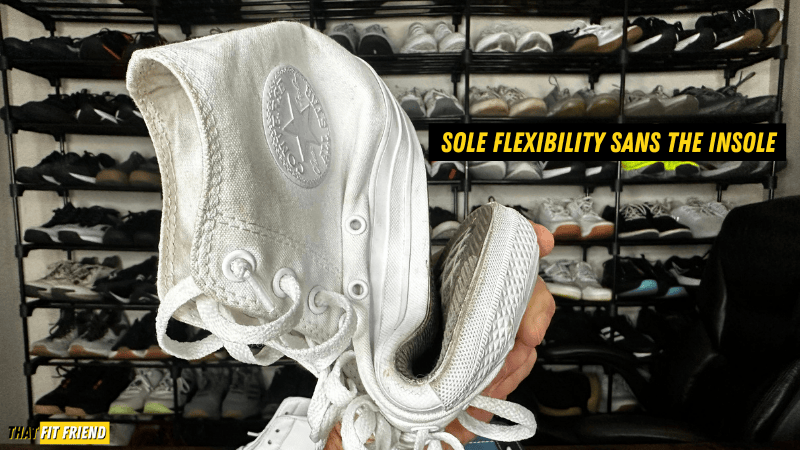
If a shoe has a higher heel-to-toe drop, then this would indicate that the heel is sitting higher than the base of the forefoot when one is wearing the shoe.
For some lifters and athletes, a 0mm heel-to-toe drop is their preferred offset. This means that their foot is sitting flat on the ground when wearing 0mm heel-to-toe drop shoes (also called zero drop shoes).
If you have ample ankle mobility and like having a flat foot position, then you’ll likely enjoy a zero drop shoe when lifting.

Note, this does not mean that lifters with good ankle mobility should only use 0mm heel-to-toe drop shoes, more so, that this type of lifter will feel that these shoes fit more naturally for them.
If we look at the context of a low heel-to-toe drop and 0mm heel-to-toe drop in different lifting settings, then it makes sense why lifters enjoy Converse for things like deadlifts and other lower body exercises.
For example, if you’re a very hip-dominant squatter, then you may not like having the additional heel elevation a cross-training shoe or weightlifting shoe can give you, so something like a Converse will generally feel more comfortable.
2. Stable Rubber Sole
The second reason lifters will reach for Converse shoes is that their soles tend to be consistent and stable under heavier loads. Converse soles are made of solid, non-compressive rubber materials, which makes them viable options for anyone who is loading their lifts fairly heavily.
This non-compressive sole is great for free weight training and tackling heavy machine work. This is also why it’s a bad idea to use running shoes for squats and deadlifts, as their more cushioned foam midsoles can compress under different weights, which can cause you to lose out on stability.

By wearing Converse shoes that offer more stability for lifting, you’ll have to stress less about balance issues and stability issues that can come with more cushioned shoes.
Plus, since Converse shoes offer a 0mm heel-to-toe drop, their sole feels consistent so there are no areas that may be more prone to compressing over others.
An example of a shoe that doesn’t offer consistent stability throughout its midsole would be some cross-training shoe models that have dual-density midsoles.
Basically, the forefoot in some of these shoes has slightly more responsive foam midsoles, while the heel is more stable. In Converse, everything is consistent under the forefoot, midfoot, and heel.
3. Great for Daily Wear
Another reason lifters reach for Converse is that they’re a great shoe for daily wear that offers some dual-functionality. Since Converse are so consistent in the gym, it’s easy to wear them out and about on a daily basis and then to the gym without worries about their performance or whether they’ll be good for heavier lifts.
There are some days that I don’t feel like bringing extra shoes along with me or in my gym bag. On days like this, I find myself constantly reaching for Converse because they look good for casual wear, but then can support 500 lb deadlifts with ease. Very few shoes can walk both of these lines very well.

Plus, Converse shoes are a fairly budget-friendly option to go with for anyone that wants a good shoe for casual wear and weight training. Most Converse shoes will cost you anywhere from $50-60 USD, which is far less than most specific weight training shoes like deadlift shoes and cross-training shoes.
Why Converse Fall Short for Lifting
Converse can work really well for lifting as a whole. However, that doesn’t mean they’re the best option to always go with. Since Converse is more general in its construction and not necessarily built for the gym, there are a few drawbacks to wearing them for training.
Their Stack Height Isn’t the Best
The first reason Converse can fall short for lifting is their stack height isn’t the best when you leave their insole in. Stack height is the metric that we use to define how much material separates the foot from the floor.
If we’re using Converse for things like deadlifts and we’re trying to get super specific with our performance, then Converse will start to fall short. For deadlifts, ideally, we want to get as close to the ground as possible.
As you get heavier or start to compete in powerlifting, these details can be a make or break from a new PR to a missed lift. If we look at a Converse and compare it to a deadlift shoe or barefoot shoes, which are both better options for deadlifting, it’s easy to see the difference in the shoe’s stack heights.
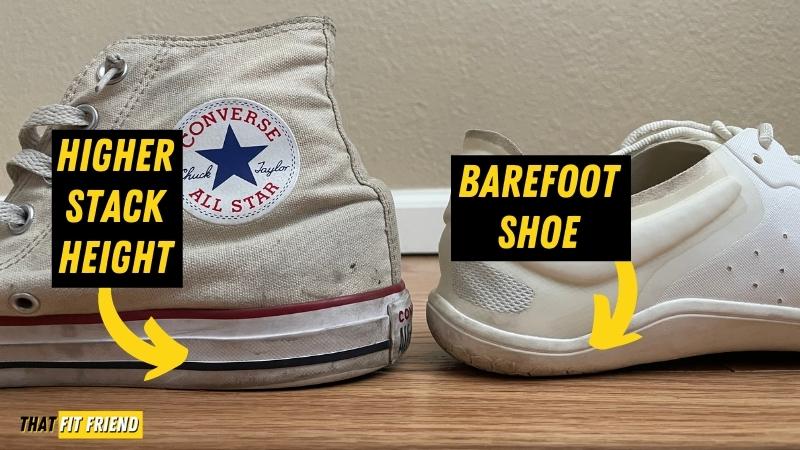
The deadlift shoes and barefoot shoes will get you much closer to the ground because their soles are often under 8mm thick whereas a Converse sole is closer to an inch if you leave the insole in as well.
For most beginners and intermediates, a Converse’s stack height isn’t the biggest deal for performance output, but it does knock the Converse as a whole a little bit.
Since we have so many different footwear options that can work really well for things like deadlifts, it’s often a good idea to get as specific as possible if you’re really trying to improve in any one area.
They Lack Versatility
Another area where Converse shoes fall short for weight training and working out is with more versatile training. If you’re tackling CrossFit workouts or functional workouts, then you’ll want to most likely skip on Converse shoes.
They offer little to no responsiveness and can be uncomfortable for plyometrics and more dynamic movement. If you regularly tackle cross-training workouts, you’ll want shoes that cater more to your workout style.
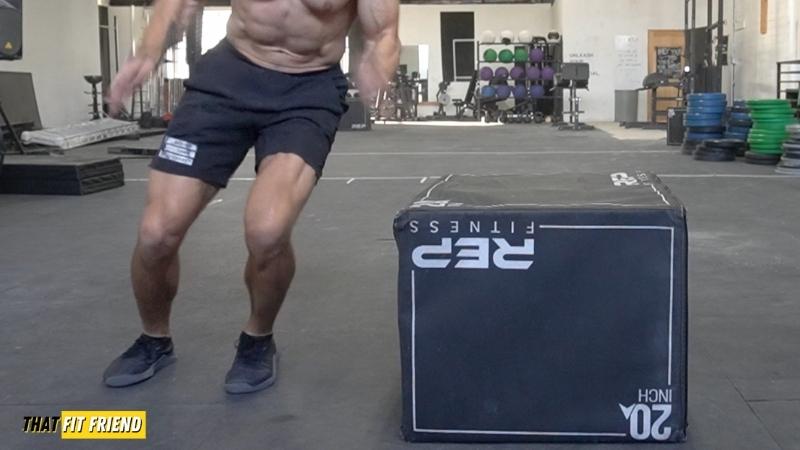
A shoe with a midsole that walks a good line between being stable and responsive will be a much better bet than using a Converse. Converse can feel heavy for these workouts and once again offer little to no responsiveness.
Plus, I think Converse can break down faster in these settings because they’re not intended to be worn for working out, especially in a dynamic manner. The upper and sole construction can run into durability issues with constant abrasion, whereas a good cross-training shoe is designed to withstand things like this.
Their Durability Can Be An Issue
Another drawback to Converse being worn for working out is that their durability can be an issue. More specifically, I think you can run into durability issues more often in the low-top Converse Chuck Taylor All-Star. I’ve had two pairs where the upper has ripped around the boot due to excessive stress.
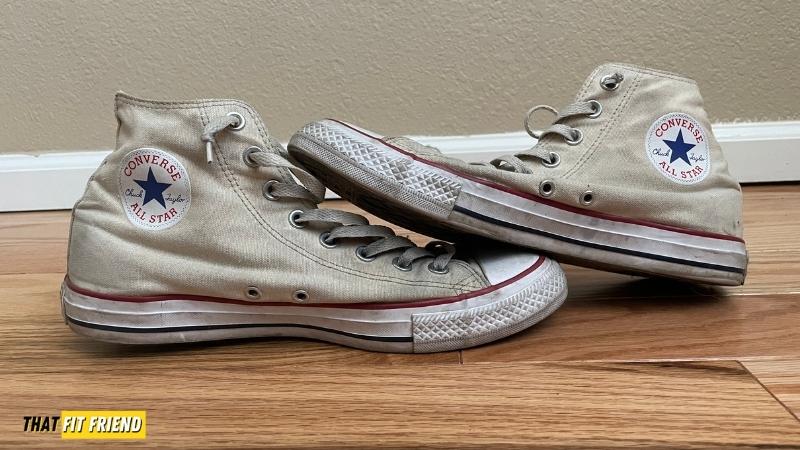
The Converse Chuck Taylor All-Star high-top model will fare better for long-term durability in the gym, but again, they still are not void of issues.
I’ve seen multiple lifters also run into issues with the Converse shoe’s sole starting to break away from the base of the forefoot. Basically, where you’ll be placing a lot of stress on the shoes during lunges and split squats.
Yes, Converse shoes are a cost-efficient option for the gym, but if you’re wearing them all of the time and on a daily basis, then I would expect them to start to show durability issues around months 8-12 which isn’t too bad for what it’s worth.
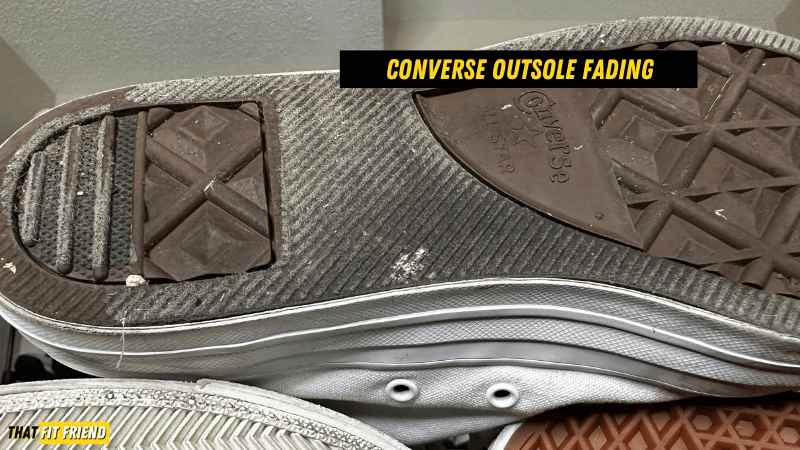
Are Converse Good for Deadlifts?
Answer: Converse can be a decent shoe option for tackling deadlifts. They offer a 0mm heel-to-toe drop when you take their insole out, which is great for keeping your foot flat and promoting balance.
Plus, their sole is stable, so it doesn’t compress under heavier loads, and the outsole provides adequate traction on a variety of surfaces in which you’ll likely be deadlifting.
If you want to be as specific as possible with your deadlift performance, Converse is a sub-par shoe. Converse can work really well for most beginners and intermediates who are building their foundation of deadlift strength, but they’ll start to fall off as you get more specific with your training.

Ideally, if you’re really pushing the limits with your deadlift performance, you’ll want a good pair of barefoot shoes, deadlift shoes, or to simply train barefoot. All of these options above will promote strong deadlifts and help you to optimize your deadlift mechanics.
The only issue with Converse for deadlifts is that they can lose outsole tread over time due to them not having fully rubber outsoles. For sumo deadlifters and lifters who pull on wooden platforms, this can be an issue for traction.
Are Converse Good for Squats?
Answer: Converse can be an okay shoe option for squats, especially for beginners, intermediates, and anyone who prefers squatting with a shoe that has a flatter sole construction.
You typically won’t run into stability issues with Converse, and they’ll provide enough traction to prevent you from slipping on rubber gym floors and wooden platforms. With their insole, they’re around a 7-8mm heel-to-toe drop shoe, and without it, they sit truer to a zero-drop shoe.
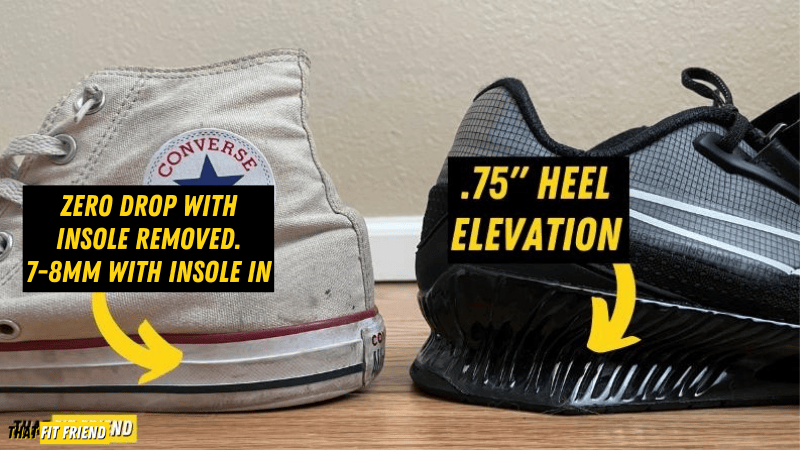
Converse shoes can fall short for squats in two key areas that require more context. The first area includes their heel-to-toe drop and how that will impact some lifters’ squat mechanics. Some lifters will benefit from squatting with weightlifting shoes or working off of a higher heel-to-toe drop.
Since Converse has closer to a zero drop, they can be uncomfortable for some lifters who may lack the levels of ankle mobility needed for them to hit adequate depth in their squats.
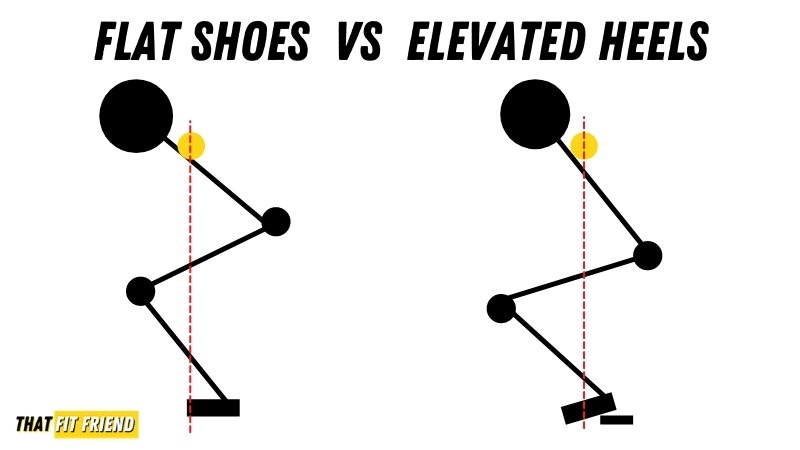
A weightlifting shoe’s heel will help lifters track their knees further over the toes while maintaining a more upright torso position, which can help with balance and squat form.
Another potential drawback to Converse for squats is their durability and limited width. I’ve had two pairs of Converse rip while squatting and that’s due to the excessive stress I placed on the canvas during my squat sessions. Another drawback is that they may feel narrow for some lifters with wider feet who prefer squat shoes with more width.

Are Converse Good for CrossFit?
Answer: Converse shoes are not going to be a good shoe for CrossFit due to its clunky and heavy sole construction, lack of durability for CrossFit WODs, and lack of midsole responsiveness.
First, their sole is not going to provide you with any level of responsiveness. This can be problematic when you’re tackling box jumps, burpees, and any other exercises where you want a little bounce in your step and movement patterns.
Second, they’re heavy and clunky. Suppose you’re tackling CrossFit workouts for time or any exercise that has a speed component. In that case, you’ll likely not enjoy how heavy Converse feels, especially for longer sessions with a speed or time element.

Third and lastly, their durability is not designed for CrossFit workouts. You’re going to want a pair of CrossFit shoes for these workouts because these shoes are purposely built to withstand high-stress areas that typically along with CrossFit. For example, most CrossFit shoes will reinforce the midfoot and toe box construction.
What Converse Are Good for Lifting?
If you’re interested in Converse shoes for lifting, then I’m going to share my thoughts on my favorite model for lifting and weight training. Over the course of my lifting career, I’ve lifted in both high-top and low-top options, and I have a preferred option for a few reasons.
That Fit Friend is supported by its readers. I [Jake Boly] run this site myself and buy the gear I review. If you purchase through my site, I may earn commissions on sales, read more here!
My Favorite Converse for Lifting: Converse Chuck Taylor All-Star (High-Top)
The Converse Chuck Taylor All-Star high-top model is my go-to Converse for lifting. These shoes are my favorite pick for a few key reasons. For starters, I love the high-top construction and think it looks great on a daily wear basis as well. I’m regularly rocking my Converse out and about and then to the gym when I don’t feel like bringing extra shoes.
I also like the feeling of the additional ankle support in the high-top model. Second, the upper construction in these fairs is a bit better for long-term use compared to the low-top model. Again, I’ve had two low-top models rip on me in the past so I don’t even bother grabbing them for training anymore.
Third and lastly, they’re consistent and cost-efficient. I like their price point and if you’re trying to save money, then looking into this model is a pretty good bet since they’re a consistent performer in the gym.
- Best For: Recreational Lifting and Casual Deadlifting
- Heel-to-Toe Drop: 0mm
- Removable Insole: Yes
- Weight: 14.3 ounces (size 10 high-top model)
- For More Info: Read My Review
What to Use Instead of Converse for Lifting
If you’re looking into Converse for lifting solely because they’re flat or because someone told you that you should, then I would suggest actually looking into other shoes because there are better options for lifting in 2023.
Converse falls short in the long run for training because it lacks specificity, which circles back to my section above discussing Converse’s shortcomings in the gym.
For example, suppose you want Converse for deadlifts, and you really want to optimize your performance and mechanics. In that case, you’d be better suited to looking into a barefoot shoe with much less stack height, as it will get you closer to the ground with more ground feedback.
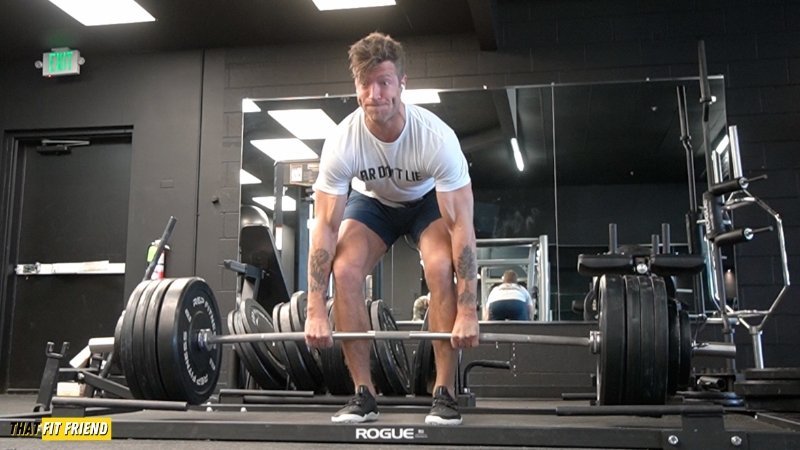
Plus, a barefoot shoe will be built wider, so you’ll have more room to splay the toes and grip the floor under you. On top of this, a Converse can lack articulation for certain lower body movements, so a thinner sole may also fare better here.
You could also explore Adidas The Total if you want a flat shoe for lifting that has a construction that is more specific to weight training. This model has a wider toe box, 0mm heel-to-toe drop, lower stack height, and an additional midfoot strap for security.

Outside of deadlifts, if you train with more versatility, then you’ll also want a shoe that delivers better performance in this context. If you wanted something flat but with a more responsive midsole, something like an Altra Solstice Xt 2 can be great.
If you want something for CrossFit or cross-training but still want to keep your heel-to-toe down or close to flat, then something like an Under Armour TriBase Reign 6 will be better. It’s stable and has a 2mm heel-to-toe drop.
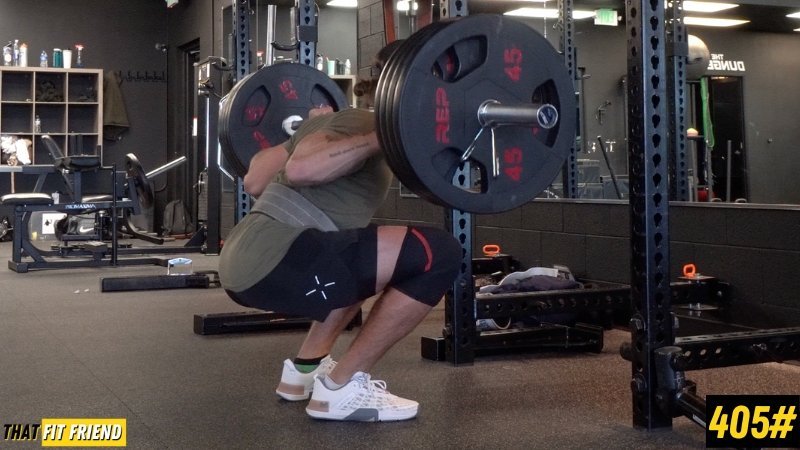
That all being said, as you get more specific with your training, then you’ll want to find shoes that will accommodate your needs better than what Converse is designed to do. At the end of the day, while Converse work, they’re not the best shoes for serious training and lifting.
Takeaway Thoughts
Converse can be a viable shoe option for the gym and when working out. They’re consistent and have a budget-friendly price which makes them a good option for a lot of beginner and intermediate lifters.
Converse is by no means the best shoe out there for lifting, but as a starter pair of lifting shoes, they can be a good option.
If you have additional questions on Converse for lifting, drop a comment below or reach out to me personally via Instagram (@jake_boly).

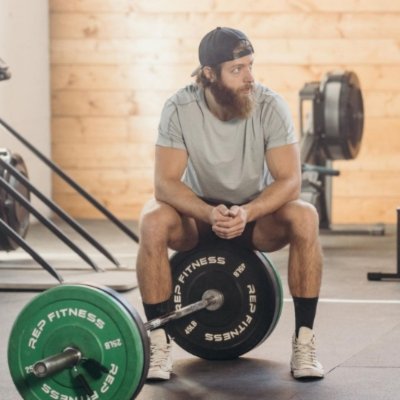

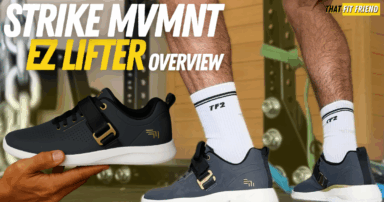
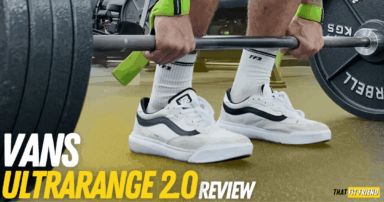
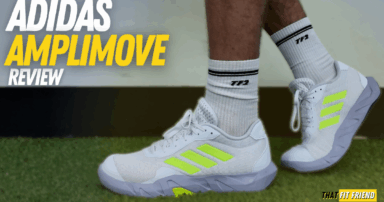
Add a Comment